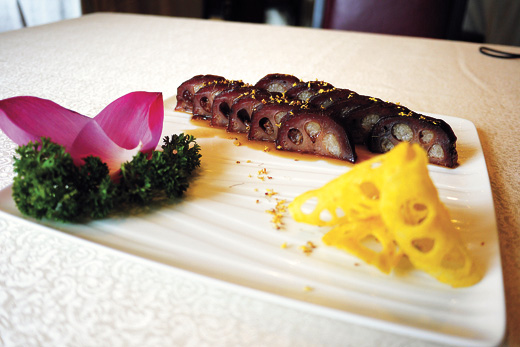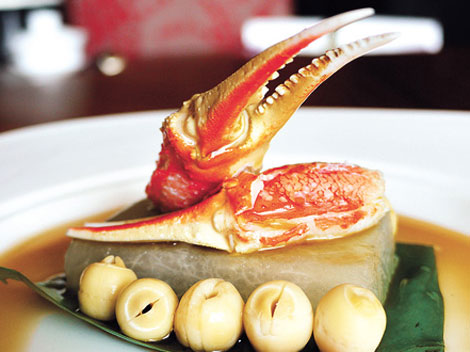Lotus root from three well-known production areas - Hangzhou and Huzhou in Zhejiang Province and Jiutang in Guangzhou, Guangdong Province - each has distinctive character.
Those from West Lake, Hangzhou, are called xishi bi (西施臂), or arm of the beauty, since it is white and slim like a lady's arm.
"That lotus root is tender and starchy, suitable for long cooking, such as steaming and stewing, to create a soft, easy-bite texture," says Kevin Kong, chef de cuisine at Chinese Private Dining in Hyatt on the Bund.
Those from Jiutang, which have high water content and low sugar, are more appropriate for stir-frying so its crispy, crunchy texture can be highlighted, he says.
The root from Huzhou, which is big, sweet and starchy, is good for slow braising, producing a soft and glutinous texture, according to chef Gu.

Lotus' natural mild flavor with different degrees of sweetness goes well with most ingredients, from meat and seafood to vegetables and mushroom. It doesn't overpower but adds fragrance, faint sweetness and textures.
Shanghai chefs commonly highlight the sweetness of lotus root by long braising with sugar and fragrance such as osmanthus, until it becomes glutinous and slightly slippery. A classic is the cold dish of lotus root sweetened with osmanthus flower.
In Sichuan cuisine, crunchy and mild lotus root is often used to balance strong ingredients. Thus, it may be added to rich and spicy hot pot.
"Besides balancing flavor, lotus root adds more texture," chef Gu says.
In Cantonese cooking, the natural taste is highlighted by simply stir-frying it with light shrimp or vegetables.
Further, lotus root is made into ou fen (藕粉), a translucent sweet, sticky starch in Hangzhou. It's stewed with pork rib in Hubei Province and fried into crispy cake in Beijing.
Lotus seed

Compared with lotus root, a favorite nationally, lotus seed is more popular in the east and south. "Serving it raw is a good way to get its natural flavor and fragrance, although there's a little bitterness left on tongue from the seed embryo," chef Gu says.
Break open the fresh seedpod, remove the sprout and pop out the seeds. The embryo can be removed to avoid the bitterness, but the embryo contains yin ("cold") energy that clears toxic heat (yang), he says.
We recommend:
